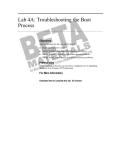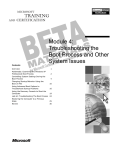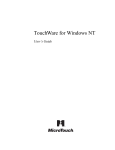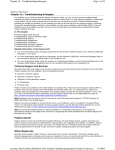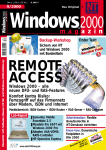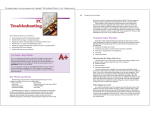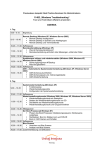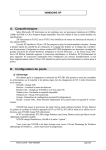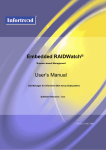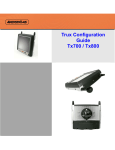Download Modifying and Troubleshooting Boot Process
Transcript
Modifying and Troubleshooting the Boot Process Page 1 of 26 Chapter 18 Modifying and Troubleshooting the Boot Process About This Chapter This chapter introduces you to the Microsoft Windows XP Professional boot process. You learn about the boot process, the BOOT.INI file, the Registry Editor, safe mode, the last known good configuration, and the Recovery Console. Before You Begin To complete this chapter, you must have A computer that meets the minimum hardware requirements listed in the preface, About This Book The Windows XP Professional software installed on your computer Lesson 1: Understanding the Boot Process In this lesson, you learn about the files used in the Windows XP Professional boot process. You also learn that the Windows XP Professional boot process occurs in five stages: the preboot sequence, boot sequence, kernel load, kernel initialization, and logon. You learn during which phase each of the boot processes are used and come to understand how to more effectively troubleshoot the Windows XP Professional boot process by learning about its files and phases. After this lesson, you will be able to Explain the boot process Describe the files used in the boot process Explain the purpose and function of the BOOT.INI file Estimated lesson time: 40 minutes Files Used in the Boot Process The boot sequence requires certain files. Table 18.1 lists the files used in the Windows XP Professional boot process, the appropriate location of each file, and the stages of the boot process associated with each file. Systemroot (typed as %systemroot%) represents the path to your Windows XP Professional installation directory, which will be C:\Windows if you've followed the installation instructions in Chapter 2, "Installing Windows XP Professional." To view the files listed in Table 18.1, open Windows Explorer and click Folder Options on the Tools menu. In the View tab of the Folder Options dialog box, under Hidden Files And Folders, click Show Hidden Files And Folders. Clear the Hide Protected Operating System Files (Recommended) check box. A Warning message box appears, indicating that it is not a good idea to display the protected operating system files. Click Yes to display them. Click OK to close the Folder Options dialog box. file://C:\Documents%20and%20Settings\alex\Local%20Settings\Temp\~hh60DF.htm 1/5/2005 Modifying and Troubleshooting the Boot Process Page 2 of 26 Table 18.1 Files Used in the Windows XP Professional Boot Process File Location Boot stage NTLDR System partition root (C:\ ) Preboot and boot BOOT.INI System partition root Boot BOOTSECT.DOS System partition root Boot (optional) NTDETECT.COM System partition root Boot NTBOOTDD.SYS System partition root Boot (optional) NTOSKRNL.EXE systemroot\System32 Kernel load HAL.DLL systemroot\System32 Kernel load SYSTEM systemroot\System32 Kernel initialization Device drivers (.sys) systemroot \System32\Drivers Kernel initialization The BOOT.INI File When you install Windows XP Professional on a computer, Windows Setup saves the BOOT.INI file in the active partition. NTLDR uses information in the BOOT.INI file to display the boot loader screen, from which you select the operating system to start. In this lesson you learn how to modify the BOOT.INI file, including modifying Advanced RISC Computing (ARC) paths and using the optional BOOT.INI switches. The BOOT.INI file includes two sections, [boot loader] and [operating systems], that contain information that NTLDR uses to create the Boot Loader Operating System Selection menu. A typical BOOT.INI might contain the following lines: [boot loader] timeout=30 default=multi(0)disk(0)rdisk(0)partition(2)\WINDOWS [operating systems] multi(0)disk(0)rdisk(0)partition(2)\WINDOWS="Microsoft Windows XP Professional" /fastdetect multi(0)disk(0)rdisk(0)partition(1)\WINNT="Windows NT Workstation Version 4.00" multi(0)disk(0)rdisk(1)partition(1)\ WINNT="Windows NT Server Workstation 4.00 [VGA mode]" /ba C:\CMDCONS\BOOTSECT.DAT="Microsoft Windows Recovery Console" /cmdcons The [operating systems] section of a BOOT.INI file that is created during a default installation of Windows XP Professional contains a single entry for Windows XP Professional. If your computer is a Microsoft Windows 95-based or Microsoft Windows 98-based dual-boot system, the [operating systems] section also contains an entry for starting the system using the other operating system. If you installed Windows XP Professional on a computer and kept an installation of Microsoft Windows NT 4.0 on another partition of the same computer, the [operating systems] section also contains an entry for starting the system using this version of Windows NT. ARC Paths During installation, Windows XP Professional generates the BOOT.INI file, which contains Advanced RISC Computing (ARC) paths pointing to the computer's boot partition. (RISC stands for Reduced Instruction Set Computing, a microprocessor design that uses a small set of simple instructions for fast file://C:\Documents%20and%20Settings\alex\Local%20Settings\Temp\~hh60DF.htm 1/5/2005 Modifying and Troubleshooting the Boot Process Page 3 of 26 execution.) The following is an example of an ARC path: multi(0)disk(0)rdisk(1)partition(2) Table 18.2 describes the naming conventions for ARC paths. Table 18.2 ARC Path Naming Conventions Convention Description The adapter/disk controller. Use scsi to indicate a Small Computer System Interface (SCSI) controller on which SCSI basic input/output system (BIOS) is not enabled. For all other Multi (x) | adapter/disk controllers, use multi, including SCSI disk controllers with the BIOS enabled. scsi (x) Here, x represents a number that indicates the load order of the hardware adapter. For example, if you have two SCSI adapters in a computer, the first to load and initialize receives number 0, and the next SCSI adapter receives number 1. Disk(y) The SCSI ID. For multi, this value is always 0. Rdisk(z) A number that identifies the disk (ignored for SCSI controllers). Partition(a) A number that identifies the partition. In both multi and scsi conventions, multi, scsi, disk, and rdisk numbers are assigned starting with 0. Partition numbers start with 1. All nonextended partitions are assigned numbers first, followed by logical drives in extended partitions. See Figure 18.1 for some examples of how to determine the ARC path name. Figure 18.1 ARC paths The scsi ARC naming convention varies the disk(y) parameter for successive disks on one controller, whereas the multi format varies the rdisk(z) parameter. BOOT.INI Switches You can add a variety of switches to the entries in the [operating systems] section of the BOOT.INI file to provide additional functionality. Table 18.3 describes some of these optional switches that you can use for entries in the BOOT.INI file. file://C:\Documents%20and%20Settings\alex\Local%20Settings\Temp\~hh60DF.htm 1/5/2005 Modifying and Troubleshooting the Boot Process Page 4 of 26 Table 18.3 BOOT.INI Optional Switches Switch Description Boots the computer using the standard Video Graphics Adapter (VGA) video driver. If a /basevideo new video driver is not working correctly, use this switch to start Windows XP Professional, and then change to a different driver. Disables serial mouse detection. Without a port specification, this switch disables /fastdetect=[comx peripheral detection on all COM ports. This switch is included in every entry in the | comx,y,z.] BOOT.INI file by default. Specifies the amount of random access memory (RAM) that Windows XP Professional /maxmem:n uses. Use this switch if you suspect that a memory chip is bad. /noguiboot Boots the computer without displaying the graphical boot status screen. Displays the device driver names as they are loading. Use this switch when startup fails /sos while loading drivers to determine which driver is triggering the failure. Modifications to BOOT.INI You can modify the time out and default parameter values in the BOOT.INI file using System Properties in Control Panel. In addition, you can manually edit these and other parameter values in the BOOT.INI file. For example, you might modify the BOOT.INI file to add more descriptive entries for the Boot Loader Operating System Selection menu or to include various switches to aid in troubleshooting the boot process. During Windows XP Professional installation, Windows Setup sets the read-only and system attributes for the BOOT.INI file. Before editing the BOOT.INI file with a text editor, you must make the file visible and turn off the read-only attribute. You can change file attributes using My Computer, Windows Explorer, or the command prompt. To change file attributes by using My Computer or Windows Explorer, complete the following steps: 1. 2. 3. 4. 5. 6. Double-click the icon for the drive containing the BOOT.INI file. On the View menu, click Folder Options. In the Folder Options dialog box, click the View tab. Under Hidden Files, click Show All Files, and then click OK. Right-click BOOT, and then click Properties. In the General tab, under Attributes, clear the Read-Only check box, and then click OK. To change file attributes using the command prompt, switch to the directory containing the BOOT.INI file if necessary, and then type attrib -s -r boot.ini After you have changed the attributes of the BOOT.INI file, you can open and modify the file using a text editor. Preboot Sequence During startup, a computer running Windows XP Professional initializes and then locates the boot portion of the hard disk. The following four steps occur during the preboot sequence: 1. The computer runs power-on self test (POST) routines to determine the amount of physical memory, file://C:\Documents%20and%20Settings\alex\Local%20Settings\Temp\~hh60DF.htm 1/5/2005 Modifying and Troubleshooting the Boot Process Page 5 of 26 whether the hardware components are present, and so on. If the computer has a Plug and Play BIOS, enumeration and configuration of hardware devices occurs at this stage. 2. The computer BIOS locates the boot device and loads and runs the master boot record (MBR). 3. The MBR scans the partition table to locate the active partition, loads the boot sector on the active partition into memory, and then executes it. 4. The computer loads and initializes the NTLDR file, which is the operating system loader. Windows XP Professional Setup modifies the boot sector during installation so that NTLDR loads during system startup. Boot Sequence After the computer loads NTLDR into memory, the boot sequence gathers information about hardware and drivers in preparation for the Windows XP Professional load phases. The boot sequence uses the following files: NTLDR, BOOT.INI, BOOTSECT.DOS (optional), NTDETECT.COM, and NTOSKRNL.EXE. The boot sequence has four phases: initial boot loader phase, operating system selection, hardware detection, and configuration selection. Initial Boot Loader Phase During the initial boot loader phase, NTLDR switches the microprocessor from real mode to 32-bit flat memory mode, which NTLDR requires to carry out any additional functions. Next, NTLDR starts the appropriate minifile system drivers. The minifile system drivers are built into NTLDR so that NTLDR can find and load Windows XP Professional from partitions formatted with file allocation table (FAT), FAT32, or NT file system (NTFS). Operating System Selection During the boot sequence, NTLDR reads the BOOT.INI file. If more than one operating system selection is available in the BOOT.INI file, then the Please Select The Operating System To Start screen appears, listing the operating systems specified in the BOOT.INI file. If you do not select an entry before the timer reaches zero, NTLDR loads the operating system specified by the default parameter in the BOOT.INI file. Windows XP Professional Setup sets the default parameter to the most recent Windows XP Professional installation. If there is only one entry in the BOOT.INI file, the Please Select The Operating System To Start screen does not appear and the default operating system is automatically loaded. If the BOOT.INI file is not present, NTLDR attempts to load Windows XP Professional from the first partition of the first disk, typically C:\. Hardware Detection NTDETECT.COM and NTOSKRNL.EXE perform hardware detection. NTDETECT.COM executes after you select Windows XP Professional on the Please Select The Operating System To Start screen (or after the timer times out). If you select an operating system other than Windows XP Professional, such as Microsoft Windows 98, NTLDR loads and executes BOOTSECT.DOS, which is a copy of the boot sector that was on the system partition at the time that Windows XP Professional was installed. Passing execution to BOOTSECT.DOS starts the boot process for the selected operating system. NTDETECT.COM collects a list of currently installed hardware components and returns this list to NTLDR for later inclusion in the registry under the HKEY_LOCAL_MACHINE\HARDWARE key. file://C:\Documents%20and%20Settings\alex\Local%20Settings\Temp\~hh60DF.htm 1/5/2005 Modifying and Troubleshooting the Boot Process Page 6 of 26 NTDETECT.COM detects the following components: Bus/adapter type Communication ports Floating-point coprocessor Floppy disks Keyboard Mouse/pointing device Parallel ports SCSI adapters Video adapters Configuration Selection After NTLDR starts loading Windows XP Professional and collects hardware information, the operating system loader presents you with the Hardware Profile/Configuration Recovery menu, which contains a list of the hardware profiles that are set up on the computer. The first hardware profile is highlighted. You can press the down-pointing arrow key to select another profile. You also can press L to invoke the LastKnownGood configuration. If there is only a single hardware profile, NTLDR does not display the Hardware Profile/Configuration Recovery menu and loads Windows XP Professional using the default hardware profile configuration. Kernel Load After configuration selection, the Windows XP Professional kernel (NTOSKRNL.EXE) loads and initializes. NTOSKRNL.EXE also loads and initializes device drivers and loads services. If you press Enter when the Hardware Profile/Configuration Recovery menu appears, or if NTLDR makes the selection automatically, the computer enters the kernel load phase. The screen clears and a series of white rectangles appears across the bottom of the screen. During the kernel load phase, NTLDR does the following: Loads NTOSKRNL.EXE but does not initialize it. Loads the hardware abstraction layer file (HAL.DLL). Loads the HKEY_LOCAL_MACHINE\SYSTEM registry key from %systemroot%\System32 \Config\System. Selects the control set it will use to initialize the computer. A control set contains configuration data used to control the system, such as a list of the device drivers and services to load and start. Loads device drivers with a value of 0x0 for the Start entry. These typically are low-level hardware device drivers, such as those for a hard disk. The value for the List entry, which is specified in the HKEY_LOCAL_MACHINE\SYSTEM\CurrentControlSet\Control\ServiceGroupOrder subkey of the registry, defines the order in which NTLDR loads these device drivers. Kernel Initialization When the kernel load phase is complete, the kernel initializes, and then NTLDR passes control to the kernel. At this point, the system displays a graphical screen with a status bar indicating load status. Four tasks are accomplished during the kernel initialization stage: 1. The Hardware key is created. On successful initialization, the kernel uses the data collected during hardware detection to create the registry key HKEY_LOCAL_MACHINE\HARDWARE. This key contains information about hardware components on the system board and the interrupts used by file://C:\Documents%20and%20Settings\alex\Local%20Settings\Temp\~hh60DF.htm 1/5/2005 Modifying and Troubleshooting the Boot Process Page 7 of 26 specific hardware devices. 2. The Clone control set is created. The kernel creates the Clone control set by copying the control set referenced by the value of the Current entry in the HKEY_LOCAL_MACHINE\SYSTEM\Select subkey of the registry. The Clone control set is never modified, as it is intended to be an identical copy of the data used to configure the computer and should not reflect changes made during the startup process. 3. Device drivers are loaded and initialized. After creating the Clone control set, the kernel initializes the low-level device drivers that were loaded during the kernel load phase. The kernel then scans the HKEY_LOCAL_MACHINE\SYSTEM\CurrentControlSet\Services subkey of the registry for device drivers with a value of 0x1 for the Start entry. As in the kernel load phase, a device driver's value for the Group entry specifies the order in which it loads. Device drivers initialize as soon as they load. If an error occurs while loading and initializing a device driver, the boot process proceeds based on the value specified in the ErrorControl entry for the driver. Table 18.4 describes the possible ErrorControl values and the resulting boot sequence actions. Table 18.4 ErrorControl Values and Resulting Action ErrorControl value 0x0 (Ignore) 0x1 (Normal) 0x2 (Severe) 0x3 (Critical) Action The boot sequence ignores the error and proceeds without displaying an error message. The boot sequence displays an error message but ignores the error and proceeds. The boot sequence fails and then restarts using the LastKnownGood control set. If the boot sequence is currently using the LastKnownGood control set, the boot sequence ignores the error and proceeds. The boot sequence fails and then restarts using the LastKnownGood control set. However, if the LastKnownGood control set is causing the critical error, the boot sequence stops and displays an error message. ErrorControl values appear in the registry under the subkey HKEY_LOCAL_MACHINE\SYSTEM\CurrentControlSet\Services\name_of_service_or_driver\ErrorControl 4. Services are started. After the kernel loads and initializes devices drivers, the Session Manager (SMSS.EXE) starts the higher order subsystems and services for Windows XP Professional. Session Manager executes the instructions in the BootExecute data item, and in the Memory Management, DOS Devices, and SubSystems keys. Table 18.5 describes the function of each instruction set and the resulting Session Manager action. Table 18.5 Session Manager Reads and Executes These Instruction Sets Data item or key BootExecute data item Memory Management key DOS Devices key SubSystems key Action Session Manager executes the commands specified in this data item before it loads any services. Session Manager creates the paging file information required by the Virtual Memory Manager. Session Manager creates symbolic links that direct certain classes of commands to the correct componentin the file system. Session Manager starts the Win32 subsystem, which controls all input/output (I/O) and access to the video screen and starts the WinLogon process. file://C:\Documents%20and%20Settings\alex\Local%20Settings\Temp\~hh60DF.htm 1/5/2005 Modifying and Troubleshooting the Boot Process Page 8 of 26 Logon The logon process begins at the conclusion of the kernel initialization phase. The Win32 subsystem automatically starts WINLOGON.EXE, which starts the Local Security Authority (LSASS.EXE) and displays the Logon dialog box. You can log on at this time, even though Windows XP Professional might still be initializing network device drivers. Next, the Service Controller executes and makes a final scan of the HKEY_ LOCAL_MACHINE\SYSTEM\CurrentControlSet\Services subkey, looking for services with a value of 0x2 for the Start entry. These services, including the Workstation service and the Server service, are marked to load automatically. The services that load during this phase do so based on their values for the DependOnGroup or DependOnService entries in the HKEY_LOCAL_MACHINE\SYSTEM\CurrentControlSet\ Services registry subkey. A Windows XP Professional startup is not considered good until a user successfully logs on to the system. After a successful logon, the system copies the Clone control set to the LastKnownGood control set. For more information on LastKnownGood configuration, see Lesson 3, "Using Startup and Recovery Tools," later in this chapter. Lesson Review The following questions will help you determine whether you have learned enough to move on to the next lesson. If you have difficulty answering these questions, review the material in this lesson before beginning the next lesson. The answers are in Appendix A, "Questions and Answers." 1. Windows XP Professional modifies the boot sector during installation so that __________ loads during system startup. 2. What is the purpose of the BOOT.INI file and what happens if it is not present? 3. What does the BOOTSECT.DOS file contain and when is it used? 4. A user calls you and tells you that Windows XP Professional does not appear to be loading correctly. The Hardware Profile/Configuration Recovery menu does not appear when the computer is restarted, but it does appear on the computer of the person sitting in the next cubicle when that computer is restarted. What would you tell the user? Lesson Summary NTLDR and NTDETECT.COM are required files in the Windows XP Professional boot process. BOOTSECT.DOS is a copy of the boot sector that was on the system partition at the time that Windows XP Professional was installed. It is only used if you choose to load an operating system other than Windows XP Professional. When you install Windows XP Professional on a computer, Windows Setup saves the BOOT.INI file in the active partition. NTLDR uses information in the BOOT.INI file to display the boot loader screen, from which you select the operating system to start. You can edit the BOOT.INI file, including modifying ARC paths and using the optional BOOT.INI file://C:\Documents%20and%20Settings\alex\Local%20Settings\Temp\~hh60DF.htm 1/5/2005 Modifying and Troubleshooting the Boot Process Page 9 of 26 switches. The Windows XP Professional boot process occurs in five phases: preboot sequence, boot sequence, kernel load, kernel initialization, and logon. Lesson 2: Editing the Registry Microsoft Windows XP Professional stores hardware and software settings centrally in a hierarchical database called the registry. The registry replaces many of the .ini, .sys, and .com configuration files used in earlier versions of Microsoft Windows. The registry controls the Windows XP Professional operating system by providing the appropriate initialization information to boot Windows XP Professional, to start applications, and to load components, such as device drivers and network protocols. Most users of Windows XP Professional never need to access the registry. However, management of the registry is an important part of the system administrator's job and includes viewing, editing, backing up, and restoring the registry. You use Registry Editor to view and change the registry configuration. After this lesson, you will be able to Identify the purpose of the registry Define the hierarchical structure of the registry View and edit the registry with Registry Editor Estimated lesson time: 60 minutes Understanding the Registry The registry contains a variety of different types of data, including the following: The hardware installed on the computer, including the central processing unit (CPU), bus type, pointing device or mouse, and keyboard. Installed device drivers. Installed applications. Installed network protocols. Network adapter card settings. Examples include the interrupt request (IRQ) number, memory base address, I/O port base address, I/O channel ready, and transceiver type. The registry structure provides a secure set of records. The data in the registry is read, updated, or modified by many of the Windows XP Professional components. Table 18.6 describes some of the components that access and store data in the registry. Table 18.6 Components That Use the Registry Component Windows XP Professional kernel Description During startup, the Windows XP Professional kernel (NTOSKRNL.EXE) reads information from the registry, including the device drivers to load and the order in which they should be loaded. The kernel writes information about itself to the registry, such as the version number. file://C:\Documents%20and%20Settings\alex\Local%20Settings\Temp\~hh60DF.htm 1/5/2005 Modifying and Troubleshooting the Boot Process Device drivers User profiles Setup programs Hardware profiles NTDETECT.COM Page 10 of 26 Device drivers receive configuration parameters from the registry. They also write information to the registry. A device driver informs the registry which system resources it is using, such as hardware interrupts or direct memory access (DMA) channels. Device drivers also report discovered configuration data. Windows XP Professional creates and maintains user work environment settings in a user profile. When a user logs on, the system caches the profile in the registry. Windows XP Professional first writes user configuration changes to the registry and then to the user profile. During setup of a hardware device or application, a setup program can add new configuration data to the registry. It can also query the registry to determine whether required components have been installed. Computers with two or more hardware configurations use hardware profiles. When Windows XP Professional starts, the user selects a hardware profile and Windows XP Professional configures the system accordingly. During system startup, NTDETECT.COM performs hardware detection. This dynamic hardware configuration data is stored in the registry. Reviewing the Hierarchical Structure of the Registry The registry is organized in a hierarchical structure similar to the hierarchical structure of folders and files on a disk. Figure 18.2 shows the hierarchical structure of the registry as displayed by the Registry Editor. Figure 18.2 Registry Editor displays the hierarchical structure of the registry Table 18.7 describes the components that make up the hierarchical structure of the registry. Table 18.7 Components That Make Up the Registry Component Description file://C:\Documents%20and%20Settings\alex\Local%20Settings\Temp\~hh60DF.htm 1/5/2005 Modifying and Troubleshooting the Boot Process Subtree Keys Entries Hive Page 11 of 26 A subtree (or subtree key) is analogous to the root folder of a disk. The Windows XP Professional registry has two subtrees: HKEY_LOCAL_MACHINE and HKEY_USERS. However, to make the information in the registry easier to find and view, there are five predefined subtrees that can be seen in the editor: HKEY_CLASSES_ROOT HKEY_CURRENT_USER HKEY_LOCAL_MACHINE HKEY_USERS HKEY_CURRENT_CONFIG Keys are analogous to folders and subfolders. Keys correspond to hardware or software objects and groups of objects. Subkeys are keys within higher level keys. Keys contain one or more entries. An entry has three parts: name, data type, and value (data or configuration parameter). A hive is a discrete body of keys, subkeys, and entries. Each hive has a corresponding registry file and .log file located in %systemroot%\ System32\Config. Windows XP Professional uses the .log file to record changes and ensure the integrity of the registry. Each entry's value is expressed as one of these data types: REG_SZ (String value). One value; Windows XP Professional interprets it as a string to store. REG_BINARY (Binary value). One value; it must be a string of hexadecimal digits. Windows XP Professional interprets each pair as a byte value. REG_DWORD (DWORD value). One value; must be a string of 1-8 hexadecimal digits. Data types REG_MULTI_SZ (Multistring value). Multiple values allowed; Windows XP Professional interprets each string as a component of multi_sz separate entries. REG_EXPAND_SZ (Expandable string value). Similar to REG_SZ, except the text can contain a replaceable variable; for example, in the string %systemroot% \NTVDM.EXE, Windows XP Professional replaces the systemroot environmental variable with the path to the Windows XP Professional System32 folder. REG_FULL_RESOURCE_DESCRIPTOR. Stores a resource list for hardware components or drivers. You cannot add or modify an entry with this data type. Registry Subtrees Understanding the purpose of each subtree can help you locate specific keys and values in the registry. The following five subtrees or subtree keys are displayed in the Registry Editor (see Figure 18.2): HKEY_LOCAL_MACHINE. Contains all configuration data for the local computer, including hardware and operating system data such as bus type, system memory, device drivers, and startup control data. Applications, device drivers, and the operating system use this data to set the computer configuration. The data in this subtree remains constant regardless of the user. HKEY_USERS. Contains two subkeys: DEFAULT. Contains the system default settings (system default profile) used to display the Ctrl+Alt+Delete logon screen, and the security identifier (SID) of the current user. HKEY_CURRENT_USER. Is a child of HKEY_USERS. HKEY_CURRENT_USER. Contains data about the current user. Retrieves a copy of each user account used to log on to the computer from the NTUSER.DAT file and stores it in the %systemroot% \Profiles\username key. This subkey points to the same data contained in HKEY_USERS\SID_currently_logged_on_user. This subtree takes precedence over HKEY_LOCAL_MACHINE for duplicated values. file://C:\Documents%20and%20Settings\alex\Local%20Settings\Temp\~hh60DF.htm 1/5/2005 Modifying and Troubleshooting the Boot Process Page 12 of 26 HKEY_CLASSES_ROOT. Contains software configuration data: object linking and embedding (OLE) and file-class association data. This subtree points to the Classes subkey under HKEY_LOCAL_MACHINE\SOFTWARE. HKEY_CURRENT_CONFIG. Contains data on the active hardware profile extracted from the SOFTWARE and SYSTEM hives. This information is used to configure settings such as the device drivers to load and the display resolution to use. The HKEY_LOCAL_MACHINE Subtree HKEY_LOCAL_MACHINE provides a good example of the subtrees in the registry for two reasons: The structure of all subtrees is similar. HKEY_LOCAL_MACHINE contains information specific to the local computer and is always the same, regardless of the user who is logged on. The HKEY_LOCAL_MACHINE root key has five subkeys, which are explained in Table 18.8. Table 18.8 HKEY_LOCAL_MACHINE Subkeys Subkey Description The type and state of physical devices attached to the computer. This subkey is volatile, meaning that Windows XP Professional builds it from information gathered during startup. HARDWARE Because the values for this subkey are volatile, it does not map to a file on the disk. Applications query this subkey to determine the type and state of physical devices attached to the computer. The directory database for the computer. The SAM hive maps to the SAM and SAM.LOG files in the %systemroot% \System32\Config directory. Applications that query SAM must SAM use the appropriate application programming interfaces (APIs). This hive is a pointer to the same one accessible under HKEY_LOCAL_MACHINE\ SECURITY\SAM. The security information for the local computer. The SECURITY hive maps to the Security and SECURITY.LOG files in the %systemroot%\System32\Config directory. SECURITY Applications cannot modify the keys contained in the SECURITY subkey. Instead, applications must query security information by using the security APIs. Information about the local computer software that is independent of per-user configuration information. This hive maps to the Software and SOFTWARE.LOG files in the % SOFTWARE systemroot%\System32\Config directory. It also contains file associations and OLE information. Information about system devices and services. When you install or configure device drivers or services, they add or modify information under this hive. The SYSTEM hive maps to the SYSTEM System and SYSTEM.LOG files in the %systemroot% \System32\Config directory. The registry keeps a backup of the data in the SYSTEM hive in the SYSTEM.ALT file. Control Sets A typical Windows XP Professional installation contains the following control set subkeys: Clone, ControlSet001, ControlSet002, and CurrentControlSet. Control sets are stored as subkeys of the registry key HKEY_LOCAL_MACHINE\SYSTEM (see Figure 18.3). The registry might contain several control sets, depending on how often you change or have problems with system settings. file://C:\Documents%20and%20Settings\alex\Local%20Settings\Temp\~hh60DF.htm 1/5/2005 Modifying and Troubleshooting the Boot Process Page 13 of 26 Figure 18.3 Registry Editor displaying the control sets The CurrentControlSet subkey is a pointer to one of the ControlSet00x keys. The Clone control set is a clone of the control set used to initialize the computer (either Default or LastKnownGood), and is created by the kernel initialization process each time you start your computer. The Clone control set is not available after you log on. To better understand control sets, you should know about the registry subkey HKEY_LOCAL_MACHINE\SYSTEM\Select. The entries contained in this subkey include the following: Current. Identifies which control set is the CurrentControlSet. When you use Control Panel options or the Registry Editor to change the registry, you modify information in the CurrentControlSet. Default. Identifies the control set to use the next time Windows XP Professional starts, unless you select the LastKnownGood configuration. Default and Current typically contain the same control set number. Failed. Identifies the control set that was designated as failed the last time the computer was started using the LastKnownGood control set. LastKnownGood. Identifies a copy of the control set that was used the last time the computer started Windows XP Professional successfully. After a successful logon, the Clone control set is copied to the LastKnownGood control set. Each of these entries in HKEY_LOCAL_MACHINE\SYSTEM\Select takes a REG_DWORD data type, and the value for each entry refers to a specific control set. For example, if the value for the Current entry is set to 0x1, the CurrentControlSet points to ControlSet001. Similarly, if the value for the LastKnownGood entry is set to 0x2, the LastKnownGood control set points to ControlSet002. Using the Registry Editor Setup installs Registry Editor (REGEDT32.EXE) in the %systemroot%\System32 directory during installation. However, because most users do not need to use Registry Editor, it does not appear on the Start menu. You start Registry Editor by selecting Run on the Start menu. Although Registry Editor allows you to perform manual edits on the registry, it is intended for file://C:\Documents%20and%20Settings\alex\Local%20Settings\Temp\~hh60DF.htm 1/5/2005 Modifying and Troubleshooting the Boot Process Page 14 of 26 troubleshooting and problem resolution. You should make most configuration changes through either Control Panel or Administrative Tools. However, some configuration settings can only be made directly through the registry. Using Registry Editor incorrectly can cause serious, system-wide problems that could require reinstallation of Windows XP Professional. When using Registry Editor to view or edit data, use a program such as Windows Backup to save a backup copy of the registry file before viewing. In Windows XP Professional, you can use Backup to back up the System State, which includes the registry, the COM class registration database, and the system boot files. Registry Editor saves data automatically as you make entries or corrections. New registry data takes effect immediately. You can select Find Key on the View menu to search the registry for a specific key. Key names appear in the left pane of Registry Editor. The search begins at the currently selected key and parses all descendant keys for the specified key name. The search is local to the subtree in which the search begins. For example, a search for a key in the HKEY_LOCAL_MACHINE subtree does not include keys under HKEY_CURRENT_USER. Practice: Using the Registry Editor In this practice, you use Registry Editor to view the information in the registry. You determine information such as the BIOS, the processor on your computer, and the version of the operating system. You use Registry Editor's Find Key command to search the registry for a specific word with key names. You then modify the registry by adding a value to it, and you save a subtree as a file so that you can use an editor, like Notepad, to search the file. Exercise 1: Exploring the Registry In this exercise, you use Registry Editor to view information in the registry. To view information in the registry 1. 2. 3. 4. 5. 6. Ensure that you are logged on as Administrator. Click Start and then click Run. In the Open text box, type Regedt32 and then click OK. Maximize the Registry Editor window, and then expand HKEY_LOCAL_MACHINE. Under HKEY_LOCAL_MACHINE, expand HARDWARE. Expand DESCRIPTION and then double-click the System subkey. What are the SystemBIOSDate and SystemBIOSVersion of your computer? What is the computer type of your local machine according to the Identifier entry? 7. Expand SOFTWARE\Microsoft\Windows NT. 8. Click CurrentVersion, and then fill in the following information. file://C:\Documents%20and%20Settings\alex\Local%20Settings\Temp\~hh60DF.htm 1/5/2005 Modifying and Troubleshooting the Boot Process Page 15 of 26 Software configuration Value and string Current build number Current version Registered organization Registered owner Exercise 2: Using the Find Command In this exercise, you use the Registry Editor's Find command to search the registry to find a specific word in the keys, values, and data in the registry. To use the find command 1. Click the HKEY_LOCAL_MACHINE subkey to ensure that the entire subtree is searched. 2. On the Edit menu, click Find. The Registry Editor displays the Find dialog box. 3. In the Find What text box, type serial, and clear Values and Data. 4. Click Find Next. The Registry Editor locates and highlights the first entry containing serial. 5. Press F3 to find the next entry containing serial. 6. Continue pressing F3 until a Registry Editor dialog box appears, indicating that Registry Editor has finished searching the registry. Notice that serial appears in many locations in the registry. 7. Click OK to close the Registry Editor dialog box. Exercise 3: Modifying the Registry In this exercise, you add a value to the registry. To add a value to the registry 1. Right-click HKEY_CURRENT_USER and then click Expand. 2. In the left pane of the Registry Editor window, click Environment. The values in the Environment key appear in the right pane of the Registry Editor window. 3. On the Edit menu, click New, and then click String Value. The Registry Editor adds A New Value #1 entry in the right pane of the Registry Editor window. 4. Type Test and then press Enter. 5. Right-click Test and then click Modify. The Registry Editor displays an Edit String dialog box. 6. In the Value Data text box, type %windir%\system32 and then click OK. file://C:\Documents%20and%20Settings\alex\Local%20Settings\Temp\~hh60DF.htm 1/5/2005 Modifying and Troubleshooting the Boot Process Page 16 of 26 Test REG_SZ %windir%\ system32 is now an entry in the right pane of the Registry Editor window. 7. Minimize the Registry Editor window. To verify the new registry value 1. Click Start, right-click My Computer, and then click Properties. The System Properties dialog box appears. 2. Click the Advanced tab, and then click Environment Variables. The Environment Variables dialog box appears. Does the test variable appear in the User Variables For Administrator list? 3. Close the Environment Variables dialog box, and then close the System Properties dialog box. Lesson Review The following questions will help you determine whether you have learned enough to move on to the next lesson. If you have difficulty answering these questions, review the material in this lesson before beginning the next lesson. The answers are in Appendix A, "Questions and Answers." 1. 2. 3. 4. 5. What is the registry and what does it do? What is the purpose of the BOOTSECT.DOS file and what happens if it is not present? What are some of the Windows XP Professional components that use the registry? How do you access the Registry Editor? Why should you make most of your configuration changes through either Control Panel or Administrative Tools rather than by editing the registry directly with the Registry Editor? Lesson Summary Windows XP Professional stores hardware and software settings in the registry, a hierarchical database that replaces many of the .ini, .sys, and .com configuration files used in earlier versions of Windows. The registry provides the appropriate initialization information to boot Windows XP Professional, to start applications, and to load components, such as device drivers and network protocols. The registry structure provides a secure set of records that can be read, updated, or modified by many of the Windows XP Professional components. The registry has two subtrees: HKEY_LOCAL_MACHINE and HKEY_USERS. The Registry Editor (REGEDT32.EXE) allows you to view and change the registry. The Registry Editor is primarily intended for troubleshooting. For most configuration changes, you should use either Control Panel or Administrative Tools, not Registry Editor. Lesson 3: Using Startup and Recovery Tools file://C:\Documents%20and%20Settings\alex\Local%20Settings\Temp\~hh60DF.htm 1/5/2005 Modifying and Troubleshooting the Boot Process Page 17 of 26 In this lesson, you learn about the tools and options Windows XP Professional provides to help you troubleshoot problems with starting your computer and recovering from disasters. These tools include safe mode, LastKnownGood configuration, the Recovery Console, and the Automated System Restore Wizard. The Automated System Restore Wizard is explained in Chapter 16, "Backing Up and Restoring Data." After this lesson, you will be able to Describe how to use safe mode Describe how to use the LastKnownGood configuration Describe the advanced boot options Install and use the Windows XP Professional Recovery Console Estimated lesson time: 60 minutes Using Safe Mode If your computer will not start, you might be able to start it by using the safe mode. Pressing F8 during the operating system selection phase displays a screen with advanced options for booting Windows XP Professional. If you select safe mode, Windows XP Professional starts with limited device drivers and system services. These basic device drivers and system services include the mouse, standard VGA monitor, keyboard, mass storage, default system services, and no network connections. Safe mode also ignores programs that automatically start up, user profiles, programs listed in the registry to automatically run, and all local group policies. Safe mode provides access to Windows XP Professional configuration files, so you can make configuration changes. You can disable or delete a system service, a device driver, or an application that automatically starts that prevents the computer from starting normally. If you choose to start your computer in safe mode, the background will be black and "Safe Mode" will appear in all four corners of the screen (see Figure 18.4). If your computer does not start using safe mode, you can try Windows XP Professional Automatic System Recovery. file://C:\Documents%20and%20Settings\alex\Local%20Settings\Temp\~hh60DF.htm 1/5/2005 Modifying and Troubleshooting the Boot Process Page 18 of 26 Figure 18.4 Running Windows XP Professional in safe mode Safe Mode with Networking There are a couple of variations of safe mode. You can select safe mode with networking, which is identical to safe mode except that it adds the drivers and services necessary to enable networking to function when you restart your computer. Safe mode with networking allows Group Policy to be implemented, including those implemented by the server during the logon process and those configured on the local computer. Safe Mode with Command Prompt A second variation of safe mode is safe mode with command prompt, which is similar to safe mode, but it loads the command interpreter as the user shell, so when the computer restarts it displays a command prompt. Using the LastKnownGood Configuration Selecting the LastKnownGood configuration advanced boot option starts Windows XP Professional using the registry information that Windows XP Professional saved at the last shutdown. If you change the Windows XP Professional configuration to load a driver and have problems rebooting, you can use the last known good process to recover your working configuration. The last known good process uses the LastKnownGood configuration, stored in the registry, to boot Windows XP Professional. Windows XP Professional provides two configurations for starting a computer, Default and LastKnownGood. Figure 18.5 shows the events that occur when you make configuration changes to your file://C:\Documents%20and%20Settings\alex\Local%20Settings\Temp\~hh60DF.htm 1/5/2005 Modifying and Troubleshooting the Boot Process Page 19 of 26 system. Any configuration changes (for example, adding or removing drivers) are saved in the Current control set. Figure 18.5 Using Default and LastKnownGood configurations After you reboot the computer, the kernel copies the information in the Current control set to the Clone control set during the kernel initialization phase. When you successfully log on to Windows XP Professional, the information in the Clone control set is copied to the LastKnownGood control set, as shown in the lower part of Figure 18.5. If you experience startup problems that you think might relate to Windows XP Professional configuration changes, shut down the computer without logging on, and then restart it. When you are prompted to select the operating system to start from a list of the operating systems specified in the BOOT.INI file, press F8 to open the Windows Advanced Options Menu screen. Then select the LastKnownGood Configuration option. The next time you log on, the Current configuration is copied to the Default configuration. If your configuration changes work correctly, the next time you log on, the Current configuration is copied to the Default configuration. If your configuration changes do not work, you can restart and use the LastKnownGood Configuration option to log on. Table 18.9 summarizes the purpose of the Default and LastKnownGood configurations. Table 18.9 Default and LastKnownGood Configurations Configuration Description Contains information that the system saves when a computer shuts down. To start a Default computer using the default configuration, select Windows XP Professional on the Please Select The Operating System To Start menu. Contains information that the system saves after a successful logon. The LastKnownGood LastKnownGood configuration loads only if the system is recovering from a severe or critical device driver loading error or if it is selected during the boot process. Table 18.10 lists situations in which you can use the LastKnownGood configuration and the related file://C:\Documents%20and%20Settings\alex\Local%20Settings\Temp\~hh60DF.htm 1/5/2005 Modifying and Troubleshooting the Boot Process Page 20 of 26 solutions. Table 18.10 Situations in Which to Use the LastKnownGood Configuration Situation Solution After a new device driver is installed, Windows XP Use the LastKnownGoodConfiguration option to start Windows XP Professional Professional restarts, but because the LastKnownGood configuration doesn't contain any reference to the the system stops new, and possibly faulty, driver. responding. Some critical drivers are written to keep users from making the mistake of You accidentally disable disabling them. With these drivers, the system automatically reverts to the a critical device driver LastKnownGood control set if a user disables the driver. If the driver does not (such as the Scsiport automatically cause the system to revert to the LastKnownGood control set, you driver). must manually select the LastKnownGood Configuration option. Using the LastKnownGood configuration does not help in the following situations: When the problem is not related to Windows XP Professional configuration changes. Such a problem might arise from incorrectly configured user profiles or incorrect file permissions. After you log on. The system updates the LastKnownGood control set with Windows XP Professional configuration changes after a successful logon. When startup failures relate to hardware failures or missing or corrupted files. Starting Windows XP Professional using the LastKnownGood configuration overwrites any changes made since the last successful boot of Windows XP Professional. Using Other Advanced Boot Options Pressing F8 during the operating system selection phase displays a screen with the Windows Advanced Options menu. This menu provides the following options: Enable Boot Logging. Selecting the Enable Boot Logging advanced boot option logs the loading and initialization of drivers and services for troubleshooting boot problems. All drivers and services that are loaded and initialized or that are not loaded in a file are logged. The log file, NTBTLOG.TXT, is located in the %windir% folder. All three versions of safe mode automatically create this boot log file. Enable VGA Mode. Selecting the Enable VGA Mode advanced boot option starts Windows XP Professional with a basic VGA driver. Directory Services Restore Mode. Selecting the Directory Services Restore Mode advanced boot option is only applicable to domain controllers, so it does not apply to computers running Windows XP Professional. Debugging Mode. Selecting the Debugging Mode advanced boot option starts Windows XP Professional in kernel debug mode, which allows a debugger to break into the kernel for troubleshooting and system analysis. When using the advanced boot options in Windows XP, logging is enabled with every option except LastKnownGood Configuration. The system writes the log file (NTBTLOG.TXT) to the %systemroot% folder. In addition, each option except LastKnownGood Configuration loads the default VGA driver. Using an advanced boot option to boot the system sets the environment variable %SAFEBOOT_OPTION% to indicate the mode used to boot the system. file://C:\Documents%20and%20Settings\alex\Local%20Settings\Temp\~hh60DF.htm 1/5/2005 Modifying and Troubleshooting the Boot Process Page 21 of 26 Using the Recovery Console The Windows XP Professional Recovery Console is a text-mode command interpreter that you can use to access NTFS, FAT, and FAT32 volumes without starting Windows XP Professional. The Recovery Console allows you to perform a variety of troubleshooting and recovery tasks, including the following: Starting and stopping services Reading and writing data on a local drive Formatting hard disks Repairing the MBR Installing and Starting the Recovery Console To install the Recovery Console, insert the Microsoft Windows XP Professional CD-ROM into your CDROM drive, and close the Microsoft Windows XP Professional CD dialog box, if it opens. Open a Run dialog box or a Command Prompt window in Windows XP Professional, change to the i386 folder on the Windows XP Professional CD, and then run the winnt32 command with the /cmdcoms switch. After you install the Recovery Console, you can use the Windows XP Professional CD-ROM to start your computer, and then to access the Recovery Console, select the Recovery Console option when you are prompted to choose repair options. After you start the Recovery Console, you must specify which installation of Window XP Professional you want to log on to (if you have a dual-boot or multiple-boot configuration), and then you must log on as the Administrator. Using the Windows XP Professional Recovery Console You can also run the Recovery Console from the Windows XP Professional CD-ROM. The Recovery Console provides a limited set of administrative commands that you can use to repair your Windows XP Professional installation. You can use the following steps to start the Recovery Console from the Windows XP Professional CD-ROM: 1. Insert the Windows XP Professional CD-ROM into the CD-ROM drive and restart the computer. If your computer or the workstation you want to repair does not have a bootable CD-ROM drive, you will need to insert your Windows XP Professional Setup Boot disk into your floppy disk drive. Insert the additional Windows XP Professional Setup disks when you are prompted to do so. 2. When Setup displays the Setup Notification message, read it, and then press Enter to continue. Setup displays the Welcome To Setup screen. In addition to the initial installation of Windows XP Professional, you can use Windows Setup to repair or recover a damaged Windows XP Professional installation. 3. Press R to repair a Windows XP Professional installation. The Windows XP Recovery Console screen appears. 4. Press C to start the Recovery Console. If you have more than one installation of Windows XP Professional on the computer, you are prompted to select which installation you want to repair. 5. Type 1 and then press Enter. file://C:\Documents%20and%20Settings\alex\Local%20Settings\Temp\~hh60DF.htm 1/5/2005 Modifying and Troubleshooting the Boot Process Page 22 of 26 You are prompted to enter the Administrator's password. 6. Type the Administrator's password and then press Enter. Setup displays a command prompt. 7. Type help and press Enter for a list of the commands available. 8. When you have completed the repair process, type exit and press Enter. The computer will restart. Understanding the Recovery Console Commands There are a number of commands available in the Recovery Console, some of which are described in Table 18.11. Table 18.11 Recovery Console Commands Command Description Changes the attributes of a file or folder. - Clears an attribute+ Sets an attribute c Compressed Attrib file attribute h Hidden file attribute r Read-only attribute s System file attribute Chdir (cd) Displays the name of the current folder or changes the current folder. Chkdsk Checks a disk and displays a status report. Cls Clears the screen. Copies a single file to another location. You can't copy a file from a hard drive to a floppy Copy disk, but you can copy a file from a floppy disk or a CD-ROM to a hard drive or from a hard drive to another hard drive. Delete Deletes one or more files. (Del) Displays a list of files and subfolders in a folder. The wildcard characters * and ? are Dir permitted. Disable Disables a system service or a device driver. Creates, deletes, and manages partitions on your hard disk. /add Creates a new partition/delete Diskpart Deletes an existing partition Do not modify the structure of dynamic disks with this command, because you might damage your partition table. Enable Starts or enables a system service or a device driver. Exit Exits the Recovery Console and restarts your computer. Expands a compressed file stored on the Windows XP Professional CD-ROM or from within Expand a .cab file and copies it to a specified destination. Fdisk Manages partitions on your hard disk. Fixboot Writes a new partition boot sector onto the system partition. Repairs the MBR of the partition boot sector. This command only overwrites the master boot Fixmbr code, leaving the existing partition table intact. If corruption in the MBR affects the partition table, running fixmbr might not resolve the problem. Format Formats a disk. If no file system is specified, NTFS is used bydefault. Help Lists the commands you can use in the Recovery Console. Logon Logs on to a Windows XP Professional installation. Map Displays the drive letter mappings. Mkdir (md) Creates a folder. file://C:\Documents%20and%20Settings\alex\Local%20Settings\Temp\~hh60DF.htm 1/5/2005 Modifying and Troubleshooting the Boot Process Page 23 of 26 More Displays a test file. Rmdir (rd) Deletes a folder. Rename Renames a single file. (ren) Sets the current folder to the %systemroot% folder of the system you are currently logged on Systemroot to. Type Displays a text file. Practice: Using the Windows XP Professional Recovery Console In this practice, you use the Windows XP Professional Recovery Console to troubleshoot a Windows XP Professional installation that will not boot. You also install and then start the Recovery Console, and you look at Help to determine what commands are available in the Recovery Console. You also use the Listsvc command to view the services and then use the Disable command to disable the Alerter service. If your computer is not equipped with a CD-ROM drive that is capable of booting from a CD-ROM, do not do Exercise 1 or you might have to reinstall Windows XP Professional. Skip to Exercise 2. Optional Exercise 1: Troubleshooting a Windows XP Professional Installation In this exercise, you troubleshoot a Windows XP Professional installation and repair it using the Recovery Console. To create a system boot failure 1. 2. 3. 4. Click Start, right-click My Computer, and then click Explore. In the left pane of the Explorer window, click Local Disk (C:). In the right pane of the Explorer window, right-click NTLDR and then click Rename. Type oldntldr and then press Enter. Windows XP Professional displays a Confirm File Rename dialog box asking if you are sure you want to rename the system file NTLDR to OLDNTLDR. 5. Click Yes. 6. Restart the computer. What error do you receive when attempting to restart the computer? To use the Recovery Console to repair the installation 1. Insert the Windows XP Professional installation CD into the CD-ROM drive and press Ctrl+Alt+Delete to restart the computer. 2. If your computer requires you to press a key to boot from the CD-ROM, press Spacebar when prompted. 3. When Setup displays the Setup Notification message, read it, and then press Enter to continue. Setup displays the Welcome To Setup screen. file://C:\Documents%20and%20Settings\alex\Local%20Settings\Temp\~hh60DF.htm 1/5/2005 Modifying and Troubleshooting the Boot Process Page 24 of 26 4. Press R to repair a Windows XP Professional installation. Setup starts the Recovery Console. 5. Type 1 and then press Enter. You are prompted to enter the Administrator's password. 6. Type password and then press Enter. Setup displays a C:\Windows command prompt. 7. Type d: and press Enter. If your CD-ROM drive is not drive d, use the correct drive letter. 8. Type cd i386 and press Enter. 9. Type dir and press Enter. Most of the files on the CD-ROM end with an _, for example, NTOSKRNL.EX_. 10. Press Spacebar to scroll through the files and locate NTLDR. NTLDR is not compressed so you can copy it directly to your computer. 11. Type copy ntldr c:\ntldr and then press Enter. When the copy is complete, Setup displays a 1 file(s) copied message. 12. If there is a disk in your floppy drive, remove it. If your computer is capable of booting from the CDROM drive, remove the Windows XP Professional CD from your CD-ROM drive. 13. Type exit and press Enter. The computer reboots and should start normally. Exercise 2: Installing the Windows XP Professional Recovery Console In this exercise, you install the Recovery Console. 1. 2. 3. 4. 5. Log on as Administrator. Insert the Windows XP Professional CD into the CD-ROM drive. When the Microsoft Windows XP Professional CD window appears, close it. Click Start, and then click Run. In the Run dialog box, type <cd-drive>:\i386\winnt32 /cmdcons (where <cd-drive> represents the letter assigned to your CD-ROM drive), and then click OK. A Windows Setup message box appears, indicating that you can install the Windows Recovery Console as a startup option. 6. Click Yes to install the Windows XP Professional Recovery Console. Windows Setup attempts to contact Microsoft and confirm that you have the latest version of Setup and then it installs the Windows XP Recovery Console on your hard disk. Windows XP Professional displays a Microsoft Windows XP Professional Setup message box file://C:\Documents%20and%20Settings\alex\Local%20Settings\Temp\~hh60DF.htm 1/5/2005 Modifying and Troubleshooting the Boot Process Page 25 of 26 indicating that the Windows Recovery Console has been successfully installed. 7. Click OK to close the Microsoft Windows XP Professional Setup dialog box. Exercise 3: Using the Windows XP Professional Recovery Console In this exercise you use the Help command to view the available commands. You then use the available Listsvc and Disable commands. 1. Restart your computer. 2. In the Please Select The Operating System To Start screen, select Microsoft Windows Recovery Console. The Microsoft Windows XP Recovery Console starts and prompts you to select which Windows installation you would like to log on to. If you had more than one Windows XP Professional installation on this computer, all of them would be listed here. 3. 4. 5. 6. Type 1 and then press Enter. Type password when prompted for the Administrator password, and then press Enter. Type help and then press Enter to see the list of available commands. Scroll through the list of commands. The Listsvc command allows you to view all the available services. 7. Type listsvc and press Enter, and then scroll through the list of available services. 8. Press Esc to stop. 9. Type disable and then press Enter. The Disable command allows you to disable a Windows system service or driver. 10. Type disable alerter and then press Enter. Recovery Console displays several lines of text describing how the registry entry for the Alerter service has been changed from Service_Demand_Start to Service_Disabled. The Alerter service is now disabled. 11. Type exit and then press Enter to restart your computer. Exercise 4: Restarting the Alerter Service In this exercise you confirm that the Alerter service is disabled and then restart it. 1. 2. 3. 4. 5. 6. 7. 8. Log on as Administrator. Click Start, click All Programs, click Administrative Tools, and then click Computer Management. In the Computer Management window, expand Services And Applications. Under Services And Applications, click Services. Double-click Alerter. In the Alerter Properties dialog box, change the Startup Type option to Automatic and then click OK. Right-click Alerter, and then click Start. Close the Computer Management window. file://C:\Documents%20and%20Settings\alex\Local%20Settings\Temp\~hh60DF.htm 1/5/2005 Modifying and Troubleshooting the Boot Process Page 26 of 26 Lesson Review The following questions will help you determine whether you have learned enough to move on to the next lesson. If you have difficulty answering these questions, review the material in this lesson before beginning the next chapter. The answers are in Appendix A, "Questions and Answers." 1. 2. 3. 4. 5. What is safe mode and why do you use it? How do you start Windows XP Professional in safe mode? When is the LastKnownGood configuration created? When do you use the LastKnownGood configuration? How can you install the Windows XP Professional Recovery Console on your computer? Lesson Summary If your computer will not start, you might be able to start it by using the safe mode because Windows XP Professional starts with limited device drivers and system services. If you change the Windows XP Professional configuration to load a driver and have problems rebooting, you can use the LastKnownGood process to recover your working configuration. Pressing F8 during the operating system selection phase displays a screen with the Windows Advanced Options menu that provides the following options: Safe Mode, Safe Mode With Networking, Safe Mode With Command Prompt, Enable Boot Logging, Enable VGA Mode, LastKnownGood Configuration, Directory Services Restore Mode, and Debugging Mode. The Windows XP Professional Recovery Console is a command-line interface that you can use to perform a variety of troubleshooting and recovery tasks. file://C:\Documents%20and%20Settings\alex\Local%20Settings\Temp\~hh60DF.htm 1/5/2005


























